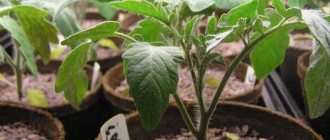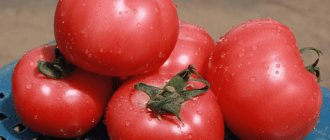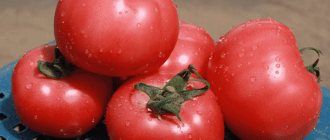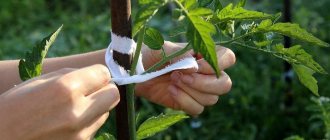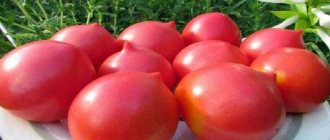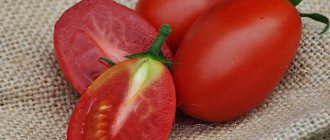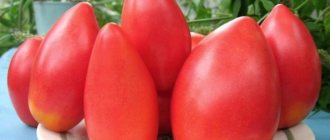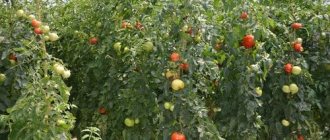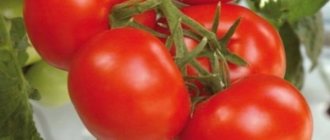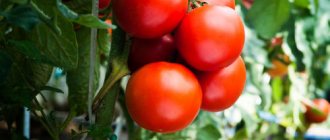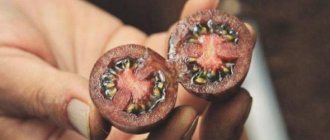In fact, the Cherry Sasha tomato is nothing but bonuses. With standard care it bears fruit beautifully. Not afraid of cold snaps and hot weather. All gardeners like it for its excellent taste and product criteria.
| Height | Landing location | Ripening time | Fruit color | Fruit size | Origin | Fruit shape |
| Tall | Greenhouse, Open ground | Early ripening | Reds | Small | Hybrid | Plum-shaped or oval |
Description and characteristics of the variety
The Valentinka cherry tomato is described as a tall tomato of the indeterminate type. The height of the stems is more than 2 meters. The variety is intended for cultivation in all regions of Russia, but only southern ones are suitable for open ground. In the middle zone, Trans-Urals and Siberia, only greenhouse cultivation is possible. Valentinka is a mid-season variety with an extended fruiting period. From germination to the first fruits, 115-120 days pass.
Cherry tomatoes are dietary tomatoes; their dry matter content is much higher than that of regular tomatoes.
Thin long stems branch abundantly, the leaves are small, standard in shape, light green. Inflorescences are formed after 8-9 leaves, the first racemes are simple, the subsequent ones are complex, branching. 24-35 “cherries” are tied on each brush. The fruits are flat-round, juicy, contain a lot of liquid, the number of seeds is average. The skin is dense, raspberry-red in color, and retains its integrity when processed with boiling water.
Description of the Valentina variety, its characteristics, growing region
Tomato Valentina was bred at the Institute of General Genetics named after N.I. Vavilov at the very end of the last millennium and registered in the State Register of the Russian Federation in 1998. It is recommended for cultivation throughout the country, where only tomatoes can, in principle, grow. As a rule, Valentina is planted in unprotected soil or in simple greenhouses: due to its low stature, it is unprofitable to occupy the expensive volume of greenhouses with this tomato. In fact, the official document recommends cultivating this variety in open ground, in personal subsidiary plots and small farms. It is also known in neighboring countries: Belarus, Ukraine, Moldova.
Tomato Valentina is one of the determinate varieties; its bushes are only 55–60 cm high, but require staking because the main stem is not very strong. Pinching is also highly recommended, although many amateurs note that without this procedure the yield does not decrease at all, and sometimes even increases. The bush is semi-spreading, there are few leaves on it, they are of normal size, light green.
Despite the compactness of the bush, it has to be tied up
Valentina is an early ripening variety: the fruits ripen a little later than three months after germination. The first inflorescence and, subsequently, the fruit cluster are formed after the 7th leaf, the subsequent ones - after 1 or 2 leaves. The fruits are below average in size, elongated oval in shape, without ribbing, weighing just under 100 g. However, the very first fruits on the bushes can also have an almost round shape. When fully ripe, tomatoes are orange-red in color and have two seed nests. The taste of fresh fruits is assessed as good. The main purpose is for whole-fruit canning, but fresh tomatoes are also used. Tomatoes of this variety, preserved in their own juice, are good: the juice content of the fruits of the Valentina variety is high, and the combination of acidity and sugar content gives the juice a bright taste.
The yield for a determinate variety is good and during industrial cultivation can be up to 440 c/ha. In the dacha version, up to 4 kg of tomatoes are harvested from one bush. The variety has increased resistance to prolonged droughts, which is a particular advantage for those amateur gardeners who can visit their plots only on weekends.
Late blight usually does not threaten this tomato, since by the time the weather deteriorates and this disease can attack, the main crop has been harvested. Other known diseases are very rare in this tomato. Since the fruits are quite dense and have a strong skin, they do not crack and are well transported over long distances, which is of interest to farmers who grow tomatoes for sale. The fruits are stored well. In general, the variety is considered easy to grow and can be recommended even to less experienced gardeners.
Video: Valentina tomato seeds
Advantages and disadvantages
Pros:
- Good yield.
- Rich sweet taste.
- The plant, covered with small red fruits, looks aesthetically pleasing.
- Suitable for whole-fruit preparations and assorted products.
- Not prone to illness.
- Fruiting from July until the onset of frost.
- Ripens in clusters.
Minuses:
- Working with tall tomatoes is inconvenient.
- They need frequent pinching, obligatory gartering, and feeding.
- Productivity is much lower than conventional tall varieties, and they take up a lot of space in the greenhouse.
- Poorly transported.
Variety care
Growing any tomatoes involves proper care, and it doesn’t matter at all whether it’s a Sanka, cherry or yellow tomato. Plant care begins from the moment the seedlings appear. It needs to be provided with sufficient lighting, hardening and watering. This is the main condition that allows you to obtain high-quality seedlings.
The Sanka tomato variety has reviews that say that after planting the seedlings, it should be properly cared for.
Therefore, if it is written that a tomato is unpretentious, this does not mean at all that it does not need to be watered and fertilized. In addition, the bush should be formed and each yellowed leaf should be removed. After all, Sanka is growing strongly to the sides, and this can interfere with the rest of the plants developing normally.
With proper care, you can get more than one fruit bush. An adult tomato Sashenka needs less care. All it needs is regular watering and feeding.
Features of cultivation and storage
In a greenhouse, a tomato grows up to 2.5 meters, so the stems must be tied to a trellis or cord stretched under the ceiling of the greenhouse. When the greens begin to fill up on the 5th cluster, the leaves below are removed. This technique will improve access of sunlight and air to the fruits. After the formation of the 8-10th cluster, the tomato is topped, leaving 2-3 leaves above the clusters to feed the plant.
Restricting growth and removing more leaves triggers the process of accelerated maturation.
The variety is not suitable for storage. Ripe fruits quickly become soft, lose their taste and presentation. The minimum shelf life is the reason why the variety is not used for commercial purposes.
Characteristics and description of the Valentine cherry tomato
The fruits of cherry tomatoes are small in size, have a sweetish taste and grow in inflorescences of 20 to 50 fruits. The Valentine cherry tomato is one of these varieties, so you need to familiarize yourself with its characteristics and agricultural technology.
Characteristics and description
The Velentinka cherry tomato belongs to indeterminate varieties, i.e. tall. The growth of bushes can continue almost indefinitely if they are not pinched. The bushes reach a height of 2 to 2.5 meters and form small leaves that must be regularly pruned. Plants also require a mandatory garter to a wooden support or twine stretched along the row. “Valentinka” shows the most optimal results when grown in 2-3 stems. After planting seedlings in the ground, the bushes form a powerful and branched root system.
The fruits are small in size (slightly larger than a large cherry), with an average weight of 16 to 25 g. Round, red, small tomatoes have an almost fruity taste. Small tomatoes are formed in the amount of 15-25 pieces on one brush. The fruits are soft and require careful handling during picking and transportation. The ripening period is from 115 to 120 days, due to which this variety is classified as mid-early.
Valentine cherry tomatoes are intended primarily for preparing salads, pizza and other dishes that require special presentation. The fruits are also good for preservation as a whole.
Productivity
Cherry tomatoes themselves are a gourmet variety, so you shouldn’t expect a large harvest from one bush, since tomatoes are small in size. On average, the yield from one bush is from 3 to 5 kg. The variety is zoned for central and southern Russia. Accordingly, in the south it can be planted and grown in open ground until the end of the growing season. In cooler regions, it is preferable to cultivate it in protected soils.
Positive and negative characteristics of the Valentine cherry variety
Of course, the positive features of Valentine cherry include the following characteristics:
A remedy that makes plants grow by leaps and bounds! Just water your plants with this Read more…
- mid-early ripening;
- a large harvest, considering that this is one of the cherry varieties;
- neat small fruits have a presentable appearance;
- resistance to common tomato diseases;
- ease of care;
- universal, suitable for indoor and outdoor ground.
The negative properties include the following:
- the need for mandatory gartering and pinching of bushes;
- soft fruits have a short shelf life and are poorly transported - they need to be placed on pallets in one layer.
Agricultural technology
Considering the difficult climatic conditions of our country, the Valentine cherry variety can only be grown using seedlings, otherwise it will not have time to ripen on time.
Important! The seeds of this tomato are sown for seedlings no later than 2 months before planting in open ground.
Preparing the substrate for seedlings
Cherries love loose, light and, at the same time, nutritious soil. As a basis for the soil mixture, you can take ordinary soil from the garden, which is mixed in equal parts with peat, river sand, and turf soil. In addition, 100 g of superphosphate and 20 g of potassium fertilizer, 2 cups of wood ash are added to one bucket of this mixture. The composition is mixed until smooth and calcined on a baking sheet in the oven at a temperature not exceeding 100 ºС.
An alternative to calcination is treating the substrate with solutions of fungicides Quadris, Ridomil Gold, Fitolavin-strobi and others. A more traditional method is spraying with a 2% manganese solution, although not all gardeners consider it effective.
Container for seedlings
There are two main options when choosing containers: a large, wide container in which the seeds will be sown; small container for 1-2 plants. On the one hand, it is easier to sow in bulk containers, and the box is more convenient to move from place to place if necessary. At the same time, initial planting in different pots makes further planting easier, because seedlings from a common pot will still be planted in separate containers.
In any case, the container for future seedlings should be thoroughly washed and treated with fungicide solutions (see names above). In addition, the pots must have a drainage hole at the bottom; if there is none, this is not difficult to do using an ordinary hot nail, which will easily melt the plastic.
Seed preparation
Valentika cherry seeds, as a rule, are already sold calibrated and processed. If they are collected at home, but damaged and obviously spoiled seeds are selected by eye. They are also tested for germination: the grains are placed on damp gauze or other fabric and left to germinate on the windowsill. In 3-5 days it will become clear: if most of the seeds have sprouted, then the seed is suitable, if not, then you should think about choosing another seed supplier.
It is equally important to treat the seeds with growth stimulants, which act as catalysts for the emergence of seedlings, make the seedlings stronger and potentially increase the future harvest. It is recommended to use growth stimulants such as sodium humate, zircon, kornevin, silk, epin and others.
Planting and caring for Valentine cherry seedlings
The prepared substrate is placed in seedling pots to half or two-thirds of their depth and watered with warm water. Tomato seeds are carefully pushed into the ground with a match, deepening no more than 1 cm. After planting the seeds, the pots are covered with plastic film or a sheet of glass; when seedlings appear, the film and glass are removed.
Important! The optimal temperature for germination and growth of Valentine cherry tomatoes is + 22ºС - + 25ºС. At temperatures above +30ºС, ovaries are formed in smaller quantities, as pollen loses fertility.
14-15 days after sowing, the first shoots appear. Seedlings dive at the stage of 1-2 true leaves, planting them in different pots and deepening them to the level of the first cotyledons. Instead, the sprouts can be laid on the ground in a spiral and buried on top with soil. The stem is laid in a spiral until the pot is completely filled with soil. This growing method allows for the formation of a powerful root system, which is especially important for indeterminate varieties.
During seedling growth, it is important not to allow the soil to dry out; it should be periodically moistened with warm water. Good results will be achieved by extending the daylight hours to 16 hours, for which purpose fluorescent lamps are installed in the room with the seedlings.
Planting seedlings in open ground
Seedlings of the Valentine cherry variety are planted in open ground when the seedlings reach no less than 30 cm in height and have 7 to 10 leaves.
The area for planting is cleared of weeds and loosened in advance. The tomato planting pattern is 40x60 cm. Each hole should be fertilized with a glass of humus and spilled with warm water, after which the seedlings are immersed in the hole and dug in. The soil around the seedlings is mulched with straw, sawdust, and mown grass.
After 14 days from the day of planting, the stem of the future bush begins to form, pinching off (pinching off) side shoots and leaves. It is most optimal to leave the main stem and one of its branches on the bush. The leaves are removed starting from the bottom and gradually moving up to the first fork of the main stem. If this is not done, the bush will form a dense crown to the detriment of yield. The bushes of the variety must be tied to wooden supports, otherwise they will drag along the ground, become dirty and rot upon contact with watered soil.
Important! When 8 to 10 inflorescences of ovaries (tassels) are formed on the bush, the main stem of the bush is pinched.
The number of weeding beds is not limited; they are carried out as necessary. Watering is done moderately, at least a couple of times a week, with the exception of rainy and cold periods, during which watering is stopped.
Also, a tomato requires at least 3-4 feedings per season. Experienced gardeners recommend alternating the application of organic matter with the application of mineral preparations. An infusion of cow manure in water for 3-5 days in a ratio of 1:10 is suitable as an organic fertilizer. This infusion is poured between the rows. The composition of mineral fertilizers includes equal parts of superphosphates, potassium salts, and moderate nitrogen fertilizers. Fertilizers are also poured between the rows.
Susceptibility to diseases and pests
The Valentine cherry variety is resistant to leaf wilting, late blight, cladosporiosis, fomoz and others. At the same time, non-compliance with agricultural practices can cause disease even in resistant varieties. It is important to carry out moderate watering; under no circumstances should water fall on the bushes and fruits. High-quality weeding and tying up bushes is another condition for disease prevention.
As for harmful insects, the Colorado potato beetle, whitefly, spider mites, slugs and others cause damage to tomatoes.
For prevention, tomato beds are treated with fungicides Barrier, Oxyx, Antrakol, Tattu, and copper sulfate. Confidor, Karbofos, Grom, Bazudin and others will save you from pests.
As a conclusion, it should be noted that Valentine cherry is a variety of gourmet tomatoes that you should pay attention to, because the price for such tomatoes is higher than usual. The yield of this variety allows it to be put into industrial use.
Reviews
Tamara, Ivanovo
I grow Valentine cherry tomatoes for sale. At the same time, I prefer to grow them in a greenhouse, since their ripening time is reduced by 15-20 days, there is no risk of damage by frost, etc. It is important to ventilate the greenhouse every day, since at very high temperatures this variety produces few ovaries, they frail and poorly ripened. Additionally, I extend the daylight hours in the greenhouse by lighting it with fluorescent lamps. In order to save money, my husband installed small windmills with coil generators, the power of which is just enough to illuminate the greenhouses.
Marina, Pskov
I don’t have a large plot, so I just grow Valentinka cherry on my balcony, because a capacity of 5-6 liters is enough for the growth of one bush. The walls of the balcony were equipped with a wooden lattice for garters. Two or three bushes are enough for my needs. However, since the bush grows in a pot, it is necessary to feed it at least 3 times with complex mineral fertilizers. I use Kemira or Universal.
otomate.ru
